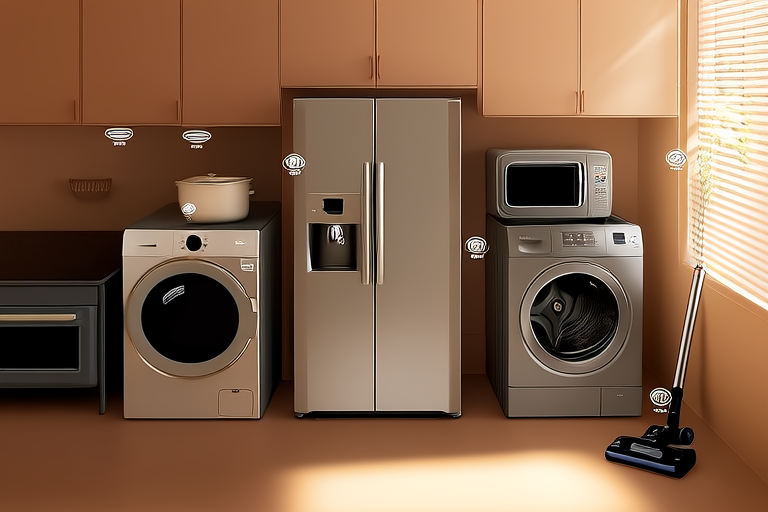The Ultimate Checklist for Regular Maintenance and Cleaning of Household Appliances
Introduction
Maintaining and cleaning household appliances is crucial for ensuring their longevity, efficiency, and safety. Neglecting regular maintenance can lead to malfunctions, higher energy consumption, and even safety hazards. By following this comprehensive checklist, you can keep your appliances running smoothly and extend their lifespan. This guide covers everything from basic cleaning tips to advanced maintenance techniques, making it suitable for both beginners and more experienced users.
Importance of Regular Maintenance
Regular maintenance not only extends the life of your appliances but also ensures they operate efficiently. Over time, dust, debris, and grease can accumulate, affecting performance and increasing energy consumption. For instance, a clogged refrigerator condenser coil can cause the unit to work harder and consume more electricity. Similarly, a dirty oven can lead to uneven cooking and potentially hazardous conditions. By staying on top of maintenance tasks, you can save money on repairs and replacements while maintaining a safe and efficient home environment.
Essential Cleaning Tips for Common Appliances
Refrigerators
- Cleaning the exterior: Start by unplugging the refrigerator and wiping down the exterior with a mild detergent solution. Pay special attention to the handles, which tend to accumulate fingerprints and grime. Use a soft cloth or sponge to avoid scratching the surface.
- Cleaning the interior: Remove all food items and wipe down shelves, drawers, and walls with a mixture of baking soda and water. This natural cleaner helps eliminate odors and bacteria. Be sure to clean the drip pan located at the bottom of the fridge as well.
- Defrosting the freezer: If your freezer develops frost buildup, it’s important to defrost it regularly. Unplug the appliance and allow the ice to melt naturally. Once melted, use a scraper to remove any stubborn ice and dry the area thoroughly before plugging it back in.
Dishwashers
- Cleaning the filter: The dishwasher filter traps food particles and other debris, so it’s essential to clean it periodically. Locate the filter, usually found at the bottom of the machine, and remove it. Rinse it under hot water and scrub away any built-up residue. Reinstall the filter and run an empty cycle with a cleaning tablet or vinegar rinse.
- Descaling: Hard water can leave mineral deposits inside the dishwasher, reducing its effectiveness. To descale, fill the detergent dispenser with white vinegar and run a full cycle. This will help remove calcium and lime buildup, ensuring optimal performance.
Ovens
- Cleaning the interior: Before cleaning, turn off the oven and allow it to cool completely. Remove racks and place them in the sink filled with warm, soapy water. Use a degreaser or baking soda paste to scrub the interior walls and door. For tough stains, apply the paste and let it sit for several minutes before wiping clean.
- Cleaning the exterior: Wipe down the exterior with a damp cloth and mild detergent. Avoid using abrasive cleaners that can scratch the surface. For stainless steel ovens, use a specialized cleaner designed for this material to maintain its shine.
Advanced Maintenance Techniques
Air Conditioners
- Checking the air filter: A clogged air filter can reduce airflow and increase energy consumption. Remove the filter and vacuum it thoroughly. If it’s heavily soiled, replace it with a new one. Ensure the filter is properly installed to prevent leaks and drafts.
- Cleaning the coils: Dust and debris can accumulate on the outdoor unit’s condenser coils, affecting cooling efficiency. Turn off the power and use a coil cleaning brush or high-pressure water spray to remove dirt. Be cautious not to damage the fins, which can affect airflow.
Washing Machines
- Cleaning the drum: Over time, lint, soap scum, and other residues can build up inside the washing machine drum. Run an empty cycle with a mixture of hot water and bleach or a commercial washing machine cleaner. This will help eliminate odors and sanitize the drum.
- Inspecting the hoses: Check the inlet and drain hoses for signs of wear or leaks. Replace any damaged hoses to prevent water damage and ensure proper function. It’s also a good idea to secure loose hoses to prevent kinking.
Practical Suggestions and Case Studies
Real-Life Example: Improving Energy Efficiency
A homeowner noticed their electric bill was unusually high despite no significant changes in usage. Upon inspection, they discovered that their refrigerator’s condenser coil was heavily clogged with dust. After cleaning the coil, the refrigerator’s energy consumption dropped significantly, resulting in substantial savings over the course of a year.
DIY Maintenance Tips
- Create a maintenance schedule: Set reminders to perform routine checks and cleaning tasks. This ensures that you don’t overlook important maintenance steps.
- Use the right tools: Invest in quality cleaning supplies and tools specifically designed for your appliances. This will make maintenance easier and more effective.
- Document your progress: Keep a log of maintenance activities, including dates and details of each task. This can be useful for troubleshooting and warranty purposes.
Conclusion
Regular maintenance and cleaning of household appliances are essential for their longevity, efficiency, and safety. By following this ultimate checklist, you can keep your appliances in top condition and enjoy a safer, more comfortable living environment. Remember to stay proactive and consistent with your maintenance routines. Not only will this save you money on repairs and replacements, but it will also contribute to a healthier and more energy-efficient home. Start today by scheduling your first round of maintenance and cleaning, and watch your appliances thrive!
